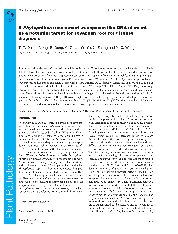摘要
A transposon-like element, A3aPro, with multiple copies in the Phytophthora sojae genome, was identified as a suitable detection target for this devastating soyabean root rot pathogen. The PCR primers TrapF1/TrapR1 were designed based on unique sequences derived from the transposon-like sequence. A 267-bp DNA fragment was amplified using this primer pair, the specificity of which was evaluated against 118 isolates of P.sojae, 72 isolates of 25 other Phytophthora spp., isolates of Pythium spp. and isolates of true fungi. In tests with P.sojae genomic DNA, detection sensitivities of 10pg and 10fg DNA were achieved in standard PCR (TrapF1/TrapR1) and nested PCR (TrapF1/TrapR1 and TrapF2/TrapR2), respectively. Meanwhile, PCR with TrapF1/TrapR1 primers detected the pathogen at the level of a single oospore, and even one zoospore. These primers also proved to be efficient in detecting pathogens from diseased soyabean tissues, residues and soils. In addition, real-time quantitative PCR (qPCR) assays coupled with the TrapF1/TrapR1 primers were developed to detect and quantify the pathogen. The results demonstrated that the TrapF1/TrapR1 and TrapF2/TrapR2 primer-based PCR assay provides a rapid and sensitive tool for the detection of P.sojae in plants and in production fields.
- 出版日期2013-6
- 单位南京农业大学
